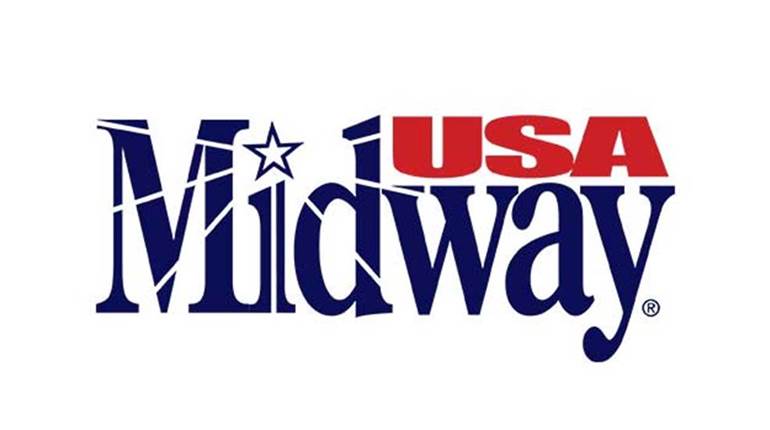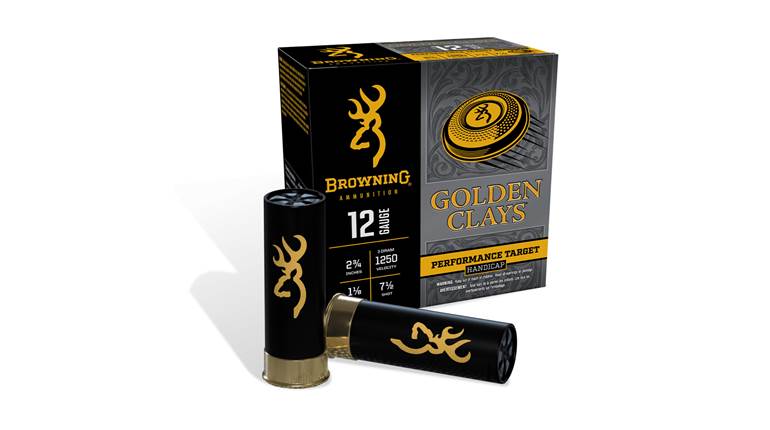
The editors of NRA’s original “Official Journal,” now celebrating 132 years of continuous publication, have, for the past 15, identified a short slate of products and individuals whose impact on the firearm industry rises above the rest. Once that list is compiled, it is further distilled—often through vigorous discussion—to a single entry in each category and winners are named to receive the NRA Publications Division’s highest honor, the Golden Bullseye Award, in recognition of their excellence in quality and innovation. As in years past, this year’s selections were made with an eye toward the trendsetters likely to have the greatest impact on NRA’s 5 million members.
“This year’s winners exemplify what NRA members want in their shooting and hunting equipment—outstanding performance, innovative design and value,” said Doug Hamlin, executive director of NRA Publications. “We congratulate those who have created the industry’s best new products and look forward to recognizing them in Atlanta.”
Criteria for the Golden Bullseye Award are stringent. To qualify, the product must have been: recently introduced and available to consumers prior to the selection of the Golden Bullseye Awards; used/tested by a staff member or regular contributor to the magazine and/or affiliated media; reliable in the field, meeting or exceeding the evaluator’s expectations; innovative in design and function; readily perceived as a value to the purchaser; and styled in a manner befitting the shooting and hunting industry and, perhaps more importantly, its enthusiasts.
And while the awards mostly acknowledge products available in the shooting sports, the Golden Bullseye Pioneer Award recognizes, “the exemplary achievement and cumulative body of work of an individual, or members of a family, team or partnership, responsible for the development and introduction of shooting equipment that has made a profound, positive and enduring impact on the way Americans shoot and hunt.”
What follows is a recap of the coverage that outlined the qualities and performance characteristics that made this year’s candidates winners in the minds of our editors. We hope you enjoy reading about them—especially if you missed them the first time around. And remember, the full stories can also be found at americanrifleman.org.
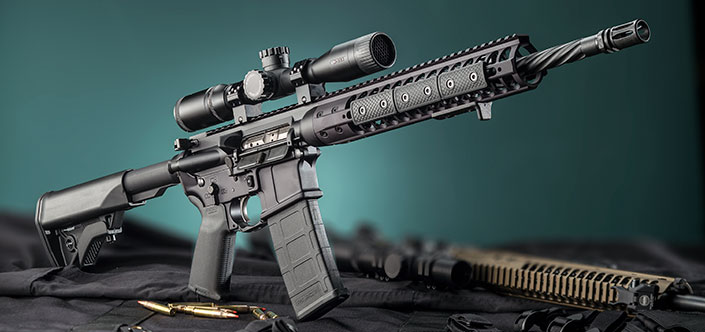
Rifle Of The Year: LWRC Int’l IC-DI
In his feature story about LWRCI’s .223-Rem.-chambered IC-DI rifle, titled “Greater Than The Sum Of Its Parts,” (February 2016, p. 52) Editor In Chief Mark A. Keefe, IV, explained that the gun was from a maker known primarily for piston-driven AR-style rifles. But he went on to explain that, even though its new model operated on the direct-gas-impingement principle, it was no ordinary AR. Keefe’s reporting on the company’s background in building sophisticated equipment for the U.S. military suggested that its surface treatments on the IC-DI had more to do with performance than appearance. Also, he described how, inside, the gun was one seriously well-thought-out piece of mechanical engineering. In fact, Keefe wrote LWRCI manufactures about 80 percent of its own parts, and it does so on machinery of the highest technology. The company even hammer forges its own barrels. “LWRCI builds its guns to its own standards of quality, and we know quality does not come cheap. Sometimes, you simply get what you pay for,” he wrote. That sentiment perfectly described a rifle that weighed in at just 6 lbs., 9 ozs., shot groups as small as 0.49" and was reasonably priced—all things that made the LWRCI IC-DI a natural candidate for Rifle Of The Year.
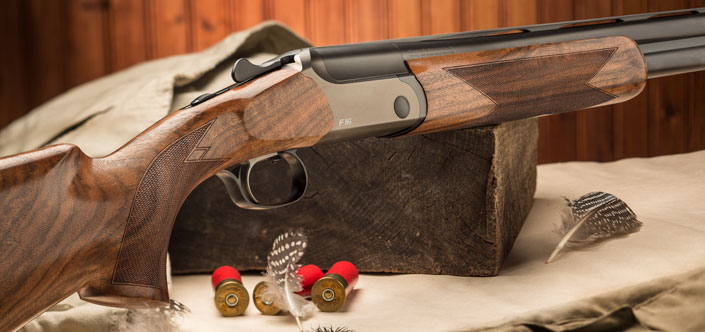
Shotgun Of The Year: Blaser F16
In our “Dope Bag” review of the Blaser F16 over-under 12-ga. shotgun (November 2016, p. 92), we noted the gun’s lowest-in-class receiver height (60 mm) and monocoque construction that mated “a conventional-looking, standing-breech receiver with a skeletal framework embedded in the front portion of the buttstock.” Along with a “bifurcated underlug” that engaged recesses in the receiver floor and trunnions on the receiver’s walls around which the monobloc hinged, the F16 benefitted from a sleekness and cost of manufacturing that meant consumers were in for a treat. “The F16 shouldered and swung easily and, as intended, pointed targets like a compass points north,” stated the review. With stock dimensions geared toward American shooters, a spare, slender fore-end, and subtle touches such as a palm swell and a gray, nickel-finished receiver that contrasted slightly with its blue barrels, the F16 won us over. We finished by writing, “… while the price remains hefty, we find it encouraging to see first-rate engineering applied to making fine guns more economical.” And, with that we selected the Blaser F16 as Shotgun Of The Year.
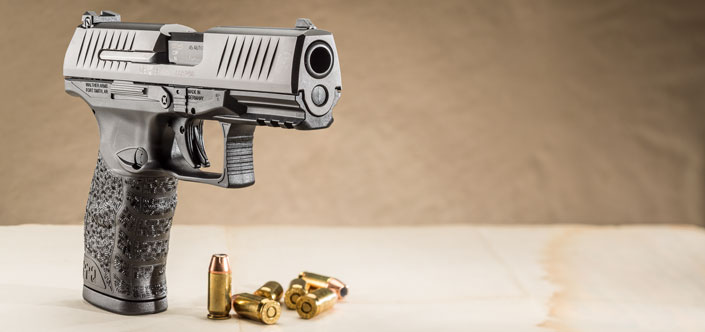
Handgun Of The Year: Walther PPQ 45
Field editor and recognized handgun authority Wiley Clapp, in a feature about the Walther PPQ 45 titled “A Big First For Walther” (October 2016, p. 56), recalled that a big-bore selfloader had been anticipated from the German maker as early as the 1930s. Fast-forwarding a few decades, Clapp wrote that the new PPQ, which held 13 rounds of .45 ACP at the ready, also offered a short trigger reset. He added, “There are a number of other features that commend the newest PPQ. Ergonomics, the physical relationship between the gun and the gunner are excellent.” Further, he wrote, “The Walther, properly handled, stays put in your hand when fired and doesn’t lift a straightened arm off target.” In testing the PPQ 45, Clapp noted that the gun never balked and described its accuracy as “excellent, probably just a little more than 2" on the average for five consecutive, five-shot groups at 25 yds.” He then added, “Shooting an old favorite load from Jeff Hoffman’s Black Hills Ammunition, I got one group of about 1¼". The gun will shoot.” With its long-awaited, and quintessentially American chambering, German engineering and manufacture, and reasonable price, the Walther PPQ 45 is well-deserving of the title Handgun Of The Year.
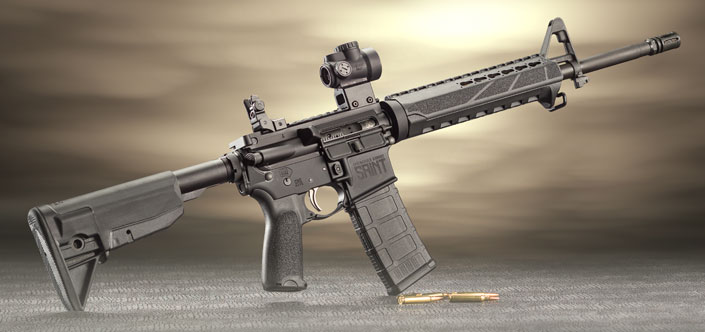
Tactical Gun Of The Year: Springfield Saint
In Managing Editor Joe Kurtenbach’s feature about the Springfield Saint, subtitled “Patron Firearm Of The Unapologetic Armed Citizen” (January 2017, p. 60), it became clear early on that this new AR-style rifle represents just the beginning for one of the oldest names in firearms. Springfield CEO Dennis Reese was quoted as saying, “The Saint has such great modularity [and can be evolved] in so many ways.” Indeed, the 16"-barreled, direct-impingement gun, with its proprietary grip shape, unique handguard, adjustable buttstock and included sights, is likely just the first model in a full line of offerings to come. Reese said that consumers can expect, “future offerings to exhibit high quality, offer real value and be ready to shoot right out of the box.” With its upper-to-lower receiver fit adjustment, 1:8" twist barrel, dual-aperture rear sight and sub-6-lb. trigger pull from nickel-boron-coated parts surfaces, Kurtenbach found the Saint easy to shoot well. In fact, the Army veteran shot several examples throughout multiple exercises and came away more than impressed. “Having sent thousands of rounds downrange, and witnessed thousands more fired by other evaluators, I found the Saint to be one of the most reliable rifles I’ve ever shot.” That brand of “faithfulness” made the Springfield Saint a perfect selection for Tactical Gun Of The Year.
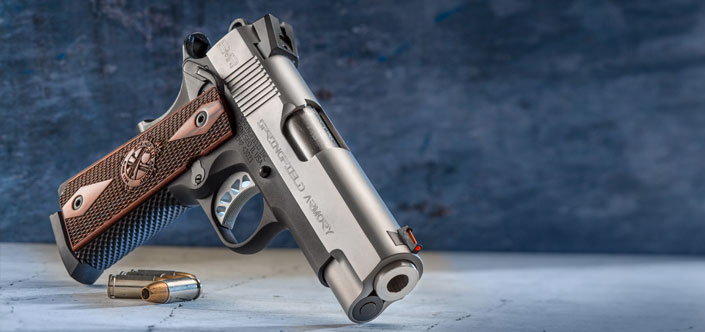
Women’s Innovation Product Of The Year: Springfield EMP4 9 mm
In a feature titled “A Classic … Optimized” (June 2016, p. 44) Clapp, who’s a bear of a man and not easily impressed by small handguns, examined a pistol that he concluded is “the first 9 mm Luger-chambered M1911 in decades that has been sized correctly for its cartridge.” He explained how the EMP4 is much more than simply a “chopped” M1911, as its grip area’s fore-aft dimension had to undergo a wholesale reduction to allow better purchase by shooters with smaller hands or shorter fingers. Clapp wrote, “To suggest that Springfield went to a bit of trouble in re-designing the EMP4’s internal parts in order to accommodate its proportional optimization would be a gross understatement. In fact, it had to re-design and manufacture 17 parts that are similar to, but differently dimensioned, than those found in a standard M1911.” Considering that the gun offers a 10-round magazine, its compact 1.25"x5.5"x7.5" dimensions and 31-oz. weight are commendable. “Since many shooters have had problems trying to teach their wives or daughters the use of the M1911 pistol, this gun might really help,” Clapp wrote. So, because of its combination of proportional engineering and shootability that any woman might find appealing, we selected the Springfield EMP4 as Women’s Innovation Product Of The Year.

Ammunition Product Of The Year: Browning Ammunition
As can be seen in the staff-generated feature titled “Browning Ammunition Makes Its Mark” (October 2016, p. 68), it isn’t every day that a major firearm maker brings to market an entire line of shotshells, rimfire cartridges, and center-fire handgun and rifle cartridges. Why? Because it’s an expensive, engineering-intensive proposition that is rife with risk. But each of the editors who sampled the new Buckmarked Browning ammunition supplied for testing, came away impressed by the cartridges’ consistency, dependability and effectiveness. Whether on whitetail deer with its BXR Rapid Expansion Matrix Tip big-game bullet in .270 Win., or on targets with the BXP hollow-point defensive bullet in .40 S&W, or on birds with its lead-shot BXD upland 12 ga. shotshells, or even in rapid fire through a Ruger 10/22 with its 40-gr. round-nose or hollow-point BPR rimfires, the Browning offerings proved themselves time and time again. In all, the new line demonstrated that the well-regarded Buckmark was in no danger of losing its luster and is likely to become even more widely known after being struck into millions of cases in the coming years. The introduction of Browning Ammunition is major news easily worthy of the claim Ammunition Product Of The Year.
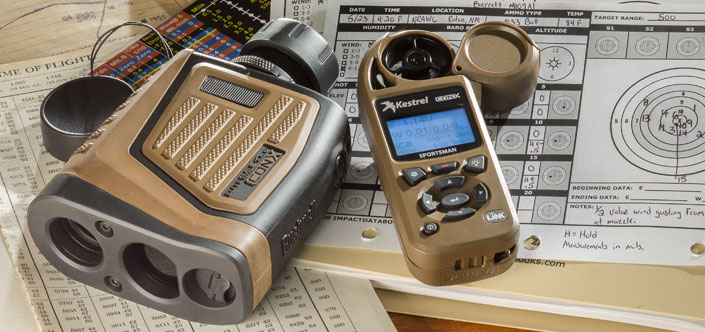
Optic Of The Year: Bushnell Elite 1 Mile CONX Combo
Associate Editor Kelly Young, in a feature titled “Confidence In A Box” (October 2016, p. 76), explained how simple and effective it is to use Bushnell’s Elite 1 Mile CONX Combo rangefinder and Kestrel windmeter. Having been fortunate enough to put the unit to the test at long range and on an aoudad hunt in West Texas, Young explained that the 7X 26 mm rangefinder, “operates by emitting a series of invisible infrared pulses and then measuring the amount of time it takes for each pulse to reflect off the target and return to the optical unit. It then calculates the distance to the target and renders it in the rangefinder’s heads-up display.” Young tested the unit for accuracy and wrote that, when it came time to pull the trigger in the field, the system was “right on the money.” Further explaining that the unit handled the intricate ballistic algorithms that confuse and slow down most shooters, Young wrote, “So how does the system work? It is simultaneously mind-numbingly complex and effortlessly simple.” He added, “It’s essentially like carrying a shooting instructor around in your pocket.” That kind of practical application of cutting-edge technology is why the Bushnell Elite 1 Mile CONX Combo is perfectly deserving of the recognition Optic Of The Year.
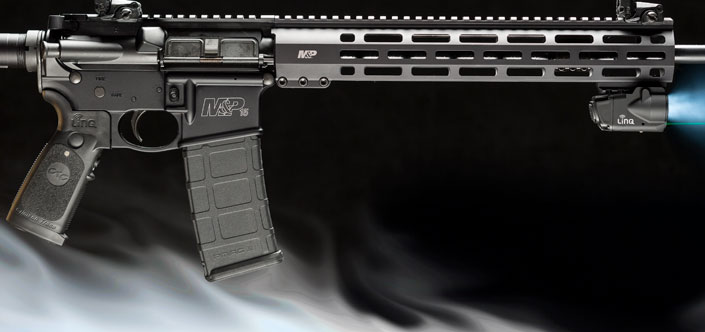
Accessory Of The Year: Crimson Trace LiNQ
Field Editor B. Gil Horman, in his feature titled “Down & Dirty With The Crimson Trace LiNQ” (January 2017, p. 88), revealed how the company’s newest product, a paired pistol grip and light/laser unit for AR-style rifles, communicated not only wirelessly but effortlessly. Horman related his experience of testing the LiNQ on a Smith & Wesson M&P rifle in, of all places, a cave below Rockcastle Shooting Center in Park City, Ky. “The alien landscape and utter darkness drove a level of concentration that was focused, to say the least. Despite the muddy conditions, humid weather and high round counts, the LiNQ proved to be a reliable shooting companion,” wrote Horman. Further, he opined, “Like the company’s other instinctive-activation Lasergrips, the LiNQ system is up and running the moment the operator grasps the grip—no fuss, no muss, just reliable illumination and laser sighting—without the hassle of support-hand activation switches or looping cables.” He concluded by writing, “It’s a system that deserves to be touted as the latest and greatest option in its class.” Such commendation is why the Crimson Trace LiNQ was named Accessory Of The Year.

Golden Bullseye Pioneer Award: Larry and Brenda Potterfield, Co-Founders Of MidwayUSA
Started as a small brick-and-mortar shop, MidwayUSA in Columbia, Mo., has become a household name across the country and is now a retail giant of the firearm trade. Equally important to NRA members and to the cause of freedom, the husband-and-wife duo that created it, Larry and Brenda Potterfield, have, along the way, devised ever new and inventive ways for firearm-industry businesses and private citizens to actively support NRA. Most prominent are two enduring and invaluable financial lifelines: 1) The NRA Round-Up Program, which provides shooting-equipment customers an opportunity to “round up” their purchases to the nearest dollar amount for donation to NRA-ILA. This began with a coin jar at the family’s early retail gun shop, then was adapted to Midway mail-order transactions and eventually adopted by other companies. To date, Midway’s Round-Up contributions come to about $13 million, and total Round-Up contributions from all donors amount to just over $17 million—funds earmarked for the NRA-ILA National Endowment for the Protection of the Second Amendment and other urgent needs. 2) At Larry’s urging, and with a helping hand from Midway, the very first Friends of NRA chapter was established in Columbia in 1992, and hosted the first Friends auction event, thus setting the stage for a groundswell of more than 20,300 events nationwide art which over 3.7 million attendees have raised more than $740 million for The NRA Foundation.
While the Potterfields have continuously innovated the pick-pack-and-ship dynamics of catalog retailing, the core principle of MidwayUSA’s business model—one that comes from both sides of the transaction—is that customer satisfaction is paramount. In 2015, the company earned its second Malcolm Baldridge National Quality Award, a prestigious recognition from the National Institute of Standards and Technology and awarded by the President of the United States to firms rated outstanding in seven criteria for performance excellence. In 1992, the Potterfields founded Battenfeld Technologies, a shooting-accessory product development and manufacturing firm that spawned popular brands such as Caldwell Shooting Supplies, Wheeler Engineering and Tipton Gun Cleaning Supplies, among others.
Larry and Brenda Potterfield identify themselves as “country kids from Missouri,” and their marksmanship skills certainly bear that out. They are passionate, worldwide hunters and ardent conservationists, both at home in Missouri and on a global scale. Both Brenda and Larry have long been known for their love of fine firearms, and for many American hunters and shooters, Larry embodies what it means to be a gun enthusiast and tinkerer, thanks in part to MidwayUSA’s long-running “thanks for your business” TV commercials. There is practically no cause for the betterment of shooting, hunting, wildlife management and firearm freedom that has not been generously supported by the Potterfield family, and in recent years they have been especially devoted to youth shooting.
Their service to NRA is unparalleled, including Brenda’s lengthy stint on the board of The NRA Foundation. Steadfast defenders of our second Amendment-protected freedoms, the Potterfields work tirelessly to encourage and counsel NRA efforts to elect gun-friendly office seekers. To that end, they are charter members of the NRA’s Ring of Freedom and hold the distinction of being charter members of the Charlton Heston Society—the Ring’s ultimate honor. They proudly wear their Golden Ring of Freedom jackets at NRA events in hopes of motivating others to follow their example.
For all of their accomplishments, Larry and Brenda Potterfield exemplify the standards that define the Golden Bullseye Pioneer Award.













